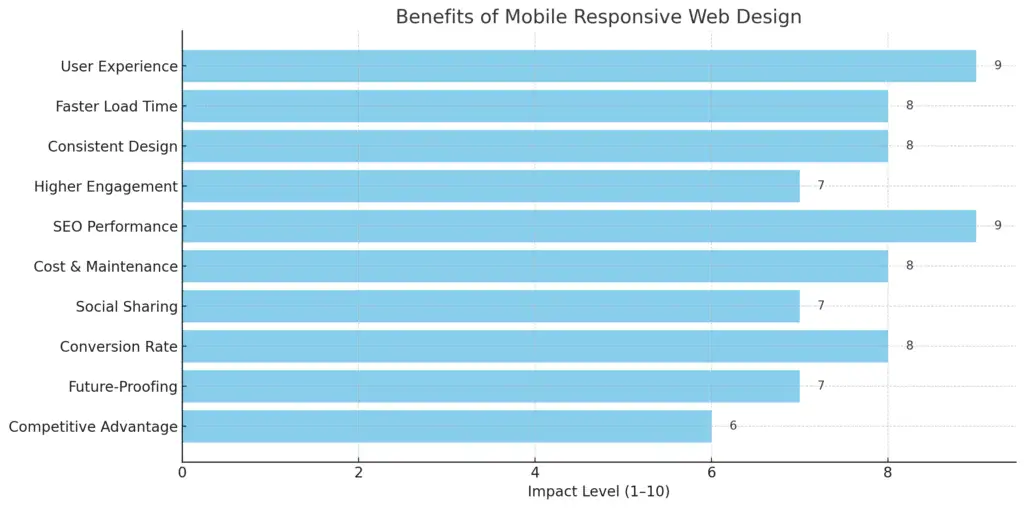A website with mobile-responsive web design will adjust its layout, content, and parts as needed depending on the viewing device’s size and screen resolution. Instead of having distinct websites for desktops, tablets, and phones, responsive design works by adjusting the layout and images using special software and CSS so the same site functions well on all devices.
-
- Key Components of Mobile Responsive Web Design
- Why is Mobile Responsive Design Essential Today?
-
Benefits of Mobile Responsive Web Design for Mobile Users
- 1. An easier user experience
- 2. Sites load more quickly on mobile devices
- 3. Playing the Same on Every Device
- 4. More People Browsing and Using Apps
- 5. Improved performance in search engine optimization
- 6. You Will Save Money, and Maintenance Takes Less Work
- 7. Social sharing was made easier
- 8. An increased number of people are becoming customers
- 9. How to Make Sure Your Website Stays New and Innovative
- 10. Competitive Advantage
- Best Practices for Implementing Mobile Responsive Design
- Conclusion
In responsive web design, images, text, buttons and menus shift to fit it the way you look at the site. A website may display its information in three columns on a computer but switch to just one column on a phone so it’s simpler for visitors to look at and move around. The aim is to allow users to access everything easily on a mobile screen without having to zoom, scroll too much or press very tiny buttons.
Key Components of Mobile Responsive Web Design
It helps to know the main parts of responsive web design to understand how it functions.
You can use Flexible Grids and Layouts
Designers can use a grid to make fluid and all-around flexible layouts. Thus, sections and their columns will change size depending on the screen size.
Responsive Images
Flexible images are accomplished by typing their width in percentages and not as fixed numbers. They can adjust to every screen size while still keeping the site fast and correct.
Media Queries
They let the website use specific styling rules that depend on a viewing device’s width, height, and resolution.
The Viewport Meta Tag
It shows the browser how to make the page fit the screen size and quality of the device which is important for making webpages look correct on smaller screens.
Why is Mobile Responsive Design Essential Today?
Because more people are using the internet on their phones, mobile-responsive web design is very important. Many studies show that a large number of people now use mobile phones to access websites. In addition, mobile-friendly websites appear higher in search engine results, and this helps SEO since Google places strong emphasis on this feature.
Users hope for simple, quick and easy-to-use apps regardless of the device they are on. When a website is not mobile-friendly, users become frustrated, bounce at a higher rate and the site may lose out on conversions. Alternatively, responsive design ensures that user experience is constant and easy, whether they are using a phone, tablet or computer.

Benefits of Mobile Responsive Web Design for Mobile Users
1. An easier user experience
Immediate and major advantages of mobile responsive web design are found in the better user experience it provides. If a site fits onto smaller screens, users can just read the content without having to zoom in or move sideways. Touching buttons is easy, menus are at hand and navigation is easy to figure out. If a site is easy to use, users tend to stay longer and keep using it.
2. Sites load more quickly on mobile devices
Removing extra elements and adjusting images to the screen size makes pages faster to load in a responsive design. Fast loading times on websites are very important for mobile users because they usually connect on cellular data or short-range Wi-Fi. Having a fast web page not only makes the user experience better but is also helpful for SEO, because Google rates pages based on how fast they are.
3. Playing the Same on Every Device
Such a website looks the same when you use it on any device. Being consistent supports your company’s brand and trust. Users have a familiar experience as the design, colors, and structure are the same across devices. Because I feel familiar with the layout, the website seems more credible.
4. More People Browsing and Using Apps
Because mobile use is growing, a responsive design allows companies to access a large group of users. Simple and clear design attracts more engagement from people who use mobile devices. With a responsive site, activities such as reading blogs, using forms, and shopping are easier, which leads to more engagement and conversions.

5. Improved performance in search engine optimization
Google uses the mobile version of websites first when indexing and giving rankings. A site that isn’t optimized for mobile devices will probably rank lower on search engines. A responsive website will better allow search engine crawlers, reduce the number of users leaving immediately, and let visitors remain for a longer period—all important search engine ranking signs.
6. You Will Save Money, and Maintenance Takes Less Work
Because of responsive design, developers do not have to create and keep two sites for various devices. Because of this, less time is needed for development, less testing is required, and maintenance efforts are reduced. All devices get the same update, which helps maintain the same performance and look everywhere.
7. Social sharing was made easier
Using social media, mobile users are often able to access interesting content. A responsive site allows users who share your content to have their followers view it on their mobile phones. More people will notice, read, share, and do something with your content, which can increase your online visibility.
8. An increased number of people are becoming customers
If users have an easy and positive experience with your mobile site, they tend to achieve the goals you set, such as buying something, subscribing to news, or contacting the business. Minimizing user struggles is possible with responsive design, which in turn results in more success in achieving business goals.
9. How to Make Sure Your Website Stays New and Innovative
New phones and tablets come out all the time, bringing bigger screens and higher resolution. With a responsive web design, your website is flexible, so it keeps working on new devices with minor adjustments. Being future-proof means your investment remains safe and useful down the road.
10. Competitive Advantage
A lot of smaller business websites struggle to properly include responsive design. Implementing a mobile-responsive site gives you a chance to be noticed in a very busy online market. A solid mobile site might allow you to surpass others who still need to improve their mobile presence.

Best Practices for Implementing Mobile Responsive Design
- All of these advantages can be reached by designers and developers who use the right methods to design websites.
- Design the site for mobile displays first and make it larger for bigger screens.
- Try to reduce image sizes and use WebP as the modern format.
- Text should be readable comfortably on the screen.
- Buttons should be sized so that they are easy to tap.
- Apply both flexible layouts and media queries using CSS efficiently.
Conclusion
All in all, having a mobile responsive website has gone from being nice to be something absolutely necessary. Since a large number of people now browse the web from mobile devices, companies have to ensure their sites are viewable on any screen. With responsive design, pages are easier to read, performance in search engines is higher, users become more involved, leads to more conversions and it saves resources in the long run. Having one experience across all devices makes things consistent with user expectations.
Going mobile responsive helps organizations keep their websites up to date and ensures they won’t lose their edge in today’s always evolving digital arena. Both small business owners and anyone working on a website or marketing should choose mobile responsive design for better growth, a larger audience and lasting trust with users.
FAQ’s
These two approaches both want websites to do better on mobile devices, but they handle it in different ways. A design made for mobile is usually not dynamic; it only shows the same pages as on a desktop, but on a smaller screen. A mobile-responsive design makes all layout pieces, fonts, and parts adapt to the screen dimensions, giving users a better experience on every device.
A mobile app is not a replacement for having a responsive website. Not everyone will want to install an app, especially if they only need it for one occasion. A responsive site makes sure that everyone, whether using a tablet, phone, or computer, experiences no problems.
Checking your website’s responsiveness is possible using:
Make your browser larger or smaller to observe how see how the layout changes.
Run tools like the Google Mobile-Friendly Test online.
Using your site on real devices that have different sizes and software.
The way Google ranks websites now is by first looking at their mobile version. Using a mobile-responsive design improves the load time, user experience, and usability, which are all helpful for SEO.





